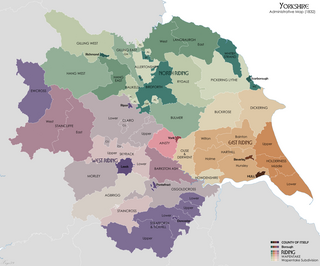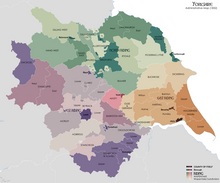
The North Riding of Yorkshire was a subdivision of Yorkshire, England, alongside York, the East Riding and West Riding. The riding's highest point was at Mickle Fell at 2,585 ft (788 m).

The Borough of Scarborough was a non-metropolitan district with borough status in North Yorkshire, England. In addition to the town of Scarborough, it covered a large stretch of the coast of Yorkshire, including Whitby and Filey. It bordered Redcar and Cleveland to the north, the Ryedale and Hambleton districts to the west and the East Riding of Yorkshire to the south.

Lythe is a small village and large civil parish, in North Yorkshire, England, situated near Whitby within the North York Moors National Park. The name of the village derives from Old Norse and means hill or slope.

Norton-on-Derwent, commonly referred to as simply Norton, is a town and civil parish in North Yorkshire, England. Norton borders the market town of Malton, and is separated from it by the River Derwent. The 2001 Census gave the population of the parish as 6,943, increasing at the 2011 Census to 7,387.

Langbaurgh was a liberty or wapentake of the North Riding of Yorkshire. It covered an area of the shire's north-eastern tip. The wapentake took its name from Langbaurgh hamlet, in present-day Great Ayton parish.

Wilton is a small village and civil parish near Pickering in North Yorkshire, England. The village is 4 miles (6.4 km) east of Pickering, 12 miles (19 km) west of Scarborough, and 10 miles (16 km) north-east of Malton.
The Forge Valley Line was a 16-mile-long branch of the North Eastern Railway between Seamer and Pickering in North Yorkshire, England. The line was intended to link Scarborough with Pickering. It opened in 1882 and closed in 1950, with the exception of a stretch from Pickering to Thornton Dale which remained open for quarry traffic until 1963.

Gransmoor is a hamlet and former civil parish, now in the parish of Burton Agnes, in the East Riding of Yorkshire, England. It is situated approximately 6 miles (10 km) south-west of the town of Bridlington and 3 miles (5 km) south-east of the village of Burton Agnes. In 1931 the parish had a population of 83.

Ganton is a village and civil parish in North Yorkshire, England. It is situated on the south side of the Vale of Pickering immediately north of the Yorkshire Wolds. Ganton lies 7 miles (11 km) west of the coastal town of Filey, and 9 miles (14 km) south-west of Scarborough.

Dickering was a wapentake of the historic East Riding of Yorkshire in England, consisting of the north-east part of that county, including the towns of Bridlington and Filey; its territory is now partly in the modern East Riding and partly in North Yorkshire. It was established in 12th or 13th century by combining the three ancient Domesday hundreds of Burton, Huntou (Hunthow) and Torbar. The Wapentake of Dickering ceased to have much significance in the 19th century when the wapentakes were superseded by other administrative divisions for most local government purposes.

Muston is a village and civil parish, in North Yorkshire, England. It was historically in the East Riding of Yorkshire. The village is situated 1.5 miles (2.4 km) south-west from the centre of the coastal town of Filey, and on the A1039 road.

Weaverthorpe is a village and civil parish in North Yorkshire, England. It is 13 miles (21 km) south-west of Scarborough.

Kettleness, is a hamlet in the Scarborough District of North Yorkshire, England. The settlement only consists of half-a-dozen houses, but up until the early 19th century, it was a much larger village. However, most of that village, which was on the headland, slipped into the sea as a result of instability caused by quarrying for the alum industry. Kettleness became a smaller settlement, with houses rebuilt slightly further inland.

Whitby Strand was a wapentake and liberty in the North Riding of Yorkshire, England. It was one of thirteen wapentakes across the old North Riding of Yorkshire. The division of the area into the Liberty and Wapentake of Whitby Strand occurred in the 14th century, previous to this, the settlements were in the wapentakes of Langbarugh and Pickering Lythe.

Marishes is a civil parish in North Yorkshire, England. The parish has an area of some 2,960 acres, and is located between Malton and Pickering in the low-lying Vale of Pickering. Whilst the main occupation of the residents in the parish is agricultural in nature, the area is known for its onshore gas field. In 2015, the population of the parish was estimated to be 140.

Falsgrave is an area of Scarborough in North Yorkshire, England. The settlement pre-dates the Domesday Book survey and was the manor which Scarborough belonged to. Gradually the settlements importance inverted, the area now a south west continuation of shops from the town centre street of Westborough. Parts of the area were designated as a conservation area in 1985. It is also where the A170 and A171 roads meet.

Throxenby is a suburb of Scarborough, in North Yorkshire, England. Historically the settlement of Throxenby was a hamlet, separated from Scarborough by countryside.

Ellerburn cum Farmanby is a former civil parish in what is the county of North Yorkshire, England. Parts of the parish straddled the road between Pickering and Thornton Dale, with the church of St Hilda, Ellerburn, being in the north of the former parish. The land of the former parish is now contained within the civil parish of Thornton Dale.


















